
DPRK - Third Visit April 13-20, 2004.
Places Visited:
Kumsusan Memorial
Korean revolutionary Museum (anti-Japanese)
Korean Folklore Museum
Pyongyang 6.9 Middle School
Pueblo
Victorious Fatherland Liberation Museum (anti-USA)
Kaesong 1 night. Panmunjom. Cement Wall.
Wonsan 1 night. Ullim Waterfall, Songdowan Int'l Childrens Camp
Changdok Middle School
Sun's Day April 15, Celebration in KIS Square
Metro from Puhung to Yonggwang
two Buddhist Temples (!)
Martyrs Cemetary
Sinchon Korean war Museum
|
Places where Visiting was refused:
Mansudae Assembly Hall
Nampo Dock, was approved then cancelled
Tongil Street Market
Tongdaewon Textile factory
a food factory and a hospital
Kaesong Industrial Park and the connected railway line
|
I have divided up the report into Direct Observations, and Personal Conclusions.
Direct Observations - click on photos to enlarge
1. As before Customs inspection for the 5 passengers on the KoryoAir Macau - Pyongyang nonstop flight was cursory. My mobile phone was
taken off me but no bags opened.
The first thing to hit me was a mile from the airport: 2 Western-style billboards for the Fiat car now assembled in the DPRK ('Whistle'.)

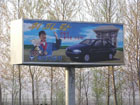
I saw a total of 6 such billboards in PY. Here are 3 more,





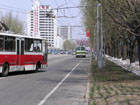 |
2. The next thing to hit me was CARS CARS and BICYCLES. The number of cars on the roads are now VERY significantly higher compared to my previous two
visits. These photos at KIS Square give an idea of the car density during the day. April 14, 2004. A year ago these streets would have at most
1 car every few minutes. Now there are so many that the Government must start a public education campaign to get people to LOOK both
ways before stepping off the kerb.
|


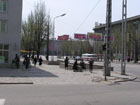 |
3. And then again a surprise was the fact that most buildings in PY have been refurbished and repainted. the roads and footpaths very
very clean. All the plastic sheeting over windows for Winter had been removed. Days were about 15-20 deg C.
Here are some general street scenes in PY last week. A similar cleanup of building and canal walls was also going on in
Wonsan, Sariwon and Kaesong. There were no blackouts or airraid drills while I was there.
|


 |
Traffic lights are only used in the middle of winter and summer. For the rest of the year here are the 'traffic lights'.
|
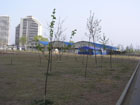 |
4. Tongil Street Market. 'The Economist' was allowed to visit this new market March 13, 2004 edition but NOT to photograph it. Well
I was refused permission to even visit it but since I knew were were going past it (Tongil Street is the main road out of PY under
the Reunification Monument - Tongil is reunification in Korean) to the
South (Panmunjon, Wonsan, Sinchon) I asked to at least be shown where it was. They allowed me to photograph the closed market (closed
for April 15 & 16, Sun's Day - Sun as in KIS is the Sun) from the
street. The logic of the decision not to allow access to their opening up is beyond me. (Of course, they are not really opening up at
all is the conclusion.) (See photos taken by Xinhua inside the market below.)
|



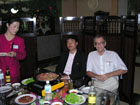 |
5. My 'Guides'. They stuck to me like leeches. Unfailingly nice and friendly but I was almost never out of their sight. Any unescorted
Westerner in PY would not get more than a few yards before someone would grab you. In Wonsan my hotel room faced the sea and after saying Goodnight
I went for a walk out on the breakwater to an island about 500 yards offshore. When I told Mr. Puk what I had done the next morning he was not happy.
After asking who saw me he explained he was responsible for me and please do not do that again.
|
Unlike my Guide last year (now in the army I was told) Mr Puk made no attempt to say how wonderful the DPRK and the Dear Leader were.
In fact, we never discussed Politics in any depth.



 |
6. With a group of Australian tourists on the Pueblo. Note the cameraman getting footage for showing on DPRK TV. We were shown a video
about it. It incorporated a technique of reversing and forwarding the video about 5 times for a 0.1 second clip to give the
appearance that the sailors with their hands up in surrender were shaking in fear. Crude of course to Western eyes familiar with movie
special effects, but to DPRK citizens who have never seen a Western film probably believable.
|
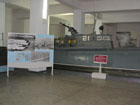 |
The Victorious Fatherland Liberation War Museum chronicle the Pueblo as being the latest in a series of illegal marine
intrusions into Korea beginning with the
American Government sending the General Sherman in 1866 (sunk and all crew killed.) Interestingly one intrusion is of the
USS Baltimore in the Korean War and its sinking by 7 DPRK torpedo boats, one of which is shown in the picture in the
basement of the Museum. No date is given. Problem is I think it is a complete fake. The USS Baltimore CA68 was decomissioned
31 May 1956. Googling 'USS Baltimore' shows no such sinking. The account of the Korean war in the same Museum is riddled
with similar made up stories so transparent that even I as an uninformed amateur could pick up on them.
|
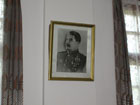 |
7. There cannot be many places today in the World where Stalin is still on display. At the old Party Headquarters.
Marx, Engles and Lenin were next to him. One thing was a
great surprise here: they played a speech by KIS from 1949 I think it was. He sounded very similar to Winston Churchill giving
his 'we will fight them on the beaches' speech. KIS was obviously a captivating speaker.
|
 |
8. KIS and KJI Rooms. Based on the Lenin and Stalin Rooms at Soviet Schools every Middle School in the DPRK has two rooms to teach a
standard litany about the Kims. This is a KIS room at a middle school. The girl is talking in the standard high falsetto voice used by
all public speakers extolling the virtues and exploits of KIS. One day a week is spent in such brainwashing .
|









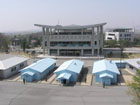 |
9. Panmunjon, DMZ. The axe from the 1976 incident. Farming inside the DMZ. ROK soldier looking in.
|
I took with me a page from the IHT of april 7 showing a photo of a DPRK soldier from the south Korean side. The commander and all
the soldiers were very thrilled to see it and clustered around. I left it for the soldier after cutting off the text of the article
below it.


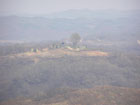 |
The Cement Wall, DMZ. We were taken to an observation post right on the northern side of the DMZ, 27 Km east of Panmunjon. You
can hear the propaganda and music from the Southern side. It seems there is a cement wall built in 1977-79 running the whole length
of the DMZ just inside the Southern demarkation line. We were told this is a de-facto border and should be torn down. The DPRK
soldier said that the Americans claimed this wall did not exist but there it is; look through the binoculars, which we dutifully did.
I was never sure I identified where it was but I would guess it is a tank trap to stop DPRK tanks.
|

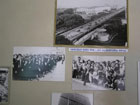 |
10. Kumsusan Memorial Palace. This is the palace where the body of KIS lies in State. It is unbelievable and breathtaking in its
presentation and implications. The tombs of Stalin, Lenin and Ho Chi Min were/are mud brick houses in comparison. The group of diplomats,
World Food Program people, and miscellaneous tourists all assembled in the carpark at the Arch of Triumph. Then we drove in
convoy to Kumsusan. No photos were allowed and all our pockets completely emptied. We were lined up in groups of 4 and rigorously checked off
Lists. The meanest bunch of plainclothed police possible ensured we were all intimidated into rigorous conformity and obedience.
There were two long
horizontal people movers (longest in the world I was told), our shoes were washed, two airlocks cleaned us, we walked past what I am
sure was a microwave scanner. All the floors and walls are marble. Then we went in to the first room and bowed to a statue of KIS. Photographs
of the westerners were taking in deep bow. And then finally into the huge darkened room with the body lying under glass. We bowed at
the feet, right side and left side of the body.
In the next room we were given a voice playback unit with an English rendition of how the korean peoples tears turned to stars in the sky
upon hearing of the death of KIS, etc. You get the picture. Marble in the floor had flecks of some stone signifying the tears shining etc.
In the final room were display cases full of medals and degrees awarded to the Dear Leader in his lifetime. The usual suspects of African
and Mid-eastern countries were the main contributors. I saw one from 'The State of Palestine'. And a degree from a USA University I had
never heard of. There were lines of hundreds of military and ordinary people outside waiting to pay homage.
I must admit I emerged into the carpark rather stunned. Alice in Wonderland came to mind. I ever knew the place existed. The visit gave
substance and inderstanding to the personality cult around the Kims.
|
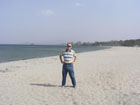 |
11. Travelling to Wonsan. Spring planting was in full swing; rice, potatoes and maize. Plowing was all by oxen. In the total journey
of 400Km I saw about 30 cars and buses amd military vehicles. But one car had rolled off the road, and no fewer than eight had
broken down by the side of the road. I saw 4 modern intercity buses for the public and one nice new Catapillar bulldozer on its primemover
followed by a big crane. The farming of mountain slopes (common a few years back) up to 30 degrees has now stopped.
|
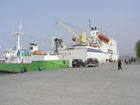 |
Wonsan is the home port of the Man Gyong Bong, which the Japanese are now thinking of banning from going to Japan. Note the vessel
next to it seems to have a lot of aerials. 'DPRK Pueblo?', I asked Mr. Puk. He laughed loudly!
|

 |
12. Sinchon War Museum. The drive to Sinchon an hour from PY goes through some of the most fertile country in the DPRK. Spring planting
was underway. I saw two ancient (Soviet?) tractors plowing. Everyone was in the fields planting. The sun was warm. It is hard
to imaging that in 1950 35,383 people were killed in 52 days by the US 8th Army. You can read the details by
googling 'Sinchon Massacre'. What I show below is what every schoolchild in the DPRK visits. The people generally are taught to hate the
Americams more than the Japanese who occupied the country from 1910 to 1945. Whether and how it happened or not is not the point.
This is what the North korean people are taught. That is the point.
|




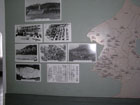 |
There are rooms full of atrocity photos: bodies cut open, torn apart, dropped down mine shafts, petrol burnt, sticks shoved
into vaginas, the torture room and associated instrumentation, etc.
|










 |
Of more interest (as if anything could be) are the painting depicting the Americans carrying out these massacres. All contain Americans
laughing. The rape of the girl has a salivating American cutting off her dress. What is worst; the idea that such things happened
or their depiction. Each picture has a story to go with it. In the last picture the North Korean fighters arrive
and exact retribution.
|



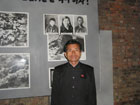 |
As in Museums the world over displaying the actual item is of great interest to visitors. I am thinking of the Apollo 7 capsule and
Lindbergs plane in The Smithsonian. In the DPRK the actual axe, the telegraph pole, torture instruments, saws, nails driven into heads, etc
from various incidents are displayed. But in Sinchon they have gone one better. In one massacre 400 women and 102 children were put
into store rooms and burnt alive December 7, 1950. Three children survived. One was 5 years old at the time and he is now 58. He was brought out
to meet me. His photo as a child is said to be the one to his right behind him.
|
13. DPRK support for China. At the anti-Japanese Museum I saw some history I did not know. The Museum claimed that North Korean
fighters fought against the Japanese in Manchuria in 1925-27, and 1937-39 under KIS (the Arduous March.) If this is true then it shows that there was
a debt owing by the Chinese to the DPRK. So (and again without knowing anything in detail) is it so unsurprising that China came into
the Korean War when the DPRK looked like being defeated? Didn't the Americans know this history in 1951 when they were approaching
the Yalu? Why did they not contact the Chinese Government and assure them that they would not cross the Yalu? Has the American Army learnt
anything about how to conduct itself in foreign wars since then?







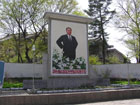 |
14. Liberally spread through every town, city and school are propaganda images of the Kims, the army and general slogans.
There must be thousands of variations. Here are 8 of them.
|

 |
15. Even as a school child KIS was the center of attention - so the story goes.
|
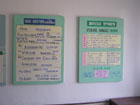  |
16. Standard of the Computer programs taught in the two middle schools I went to. Windows 98 was being used in one school. I saw
a boy typing in his password. I told Mr. Puk that passwords were not needed in W98 and I showed the boy just to hit Enter. He seemed
genuinely surprised! No doubt they go from 10 years behind the times to only 5 years when they go to University. I wonder how they
reconcile the fact that all these advances - hardware & software - are coming from their hated enemy America and not from within the DPRK. |
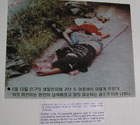 |
17. Everywhere you go, sometimes when least expected, there are anti-American sentiments expressed. Russia is never mentioned, and the
Chinese only a little when they helped in the Korean War (!) I only saw this photo once - at the Songdowon Int'l Childrens camp in
Wonsan. It shows the two girls run over and killed in South Korea in 6/2002. The brains of one girl are spewed out on the road. The
English text gives you an idea of the anti-American sentiments one gets used to hearing.
|
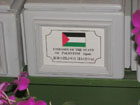 |
18. At the Kimilsungia Flower Exhibition (a Begonia hybrid bred for KIS in Indonesia in the 1960's I think) one of the contributors
was 'The State of Palestine'.
|
Personal Conclusions
1984 is the DPRK. Or go and see The Godfather trilogy; that is how the DPRK works at the top.
1. Reunification. Forget it. It is never going to happen. It is a pipe-dream being peddled to the DPRK masses. The USA is
the bad guy always finding excuses to stop it. All media from outside the DPRK is banned - no radio, newspapers, movie films. Personal
contact of foreigners by local people is banned.
2. Collapse from Within. Forget it. The indoctrination system for the masses is now so well honed that I see no sign of
discontent. As long as the Kim Family look after the top cadres and the Army with gifts and perks the Family will be secure.
People have been predicting the
demise of the DPRK for years. Most recently Victor Cha in testimony to the Senate Foreign Relations Committee (March 2, 2004)
said: "the overturning of systems like North Korea occur not when things are at their worst, but when they begin to get better." Well
sorry, but there has never been a socialist state like the DPRK where information is totally controlled. KJI almost never appears
in public no doubt remembering how Ceausescu met his end - boos from the masses. In Eastern Europe TV and newspapers freely flowed
over the borders.
Also it is certainly NOT in the interests of South Korea to have 10 million people walking into Seoul over the DMZ.
A coup? Well from what I have read 2 or 3 coups have been ruthelessly suppressed over the last 10 years. Possible, but I would not
bet on it.
3. Is Change Possible? Yes. In a word, China. The balancing act the DPRK will have to do to make China happy is where the action will
be in the next years. Will the DPRK do a deal to get rid of nuclear weapons? I doubt it. Maybe they will put them under joint
Chinese/DPRK control. How far will the DPRK go to allow in Western cars and
consumer goods? Not very far I suspect. But of course I don't know. But two things I do know:
- if the DPRK masses ever get to see South Korean TV they will not be happy to have been misled for so long, and
- I am sick of reading articles and opinions about the DPRK by people who have never been there! It has taken me three visits
to finally get an insight into how the place operates. How can some lawyer in Seoul or a Presidential advisor inside the Washington
Beltway reading 'intelligence' Reports hope to understand the DPRK if they have never visited Kumsusan Palace, Sinchon Museum
and a host of other places?
4. A Role for the USA? I doubt it. There has been a Stalemate at the DMZ for over 50 years. Why should it change? The
DPRK will not invade the South and the
South certainly will not invade the North for all the known reasons. And from an historical point-of-view the USA are not exactly
endowed with great perspicacity when it comes to foreign wars, occupations and interventions. How popular are the Americans in South Korea?
Why? I have never been there but that will be my next visit. I have recently seen the problem described as American narcissism.
5. Public Obeisance, Private Doubt. The Children are brought up to think that the DPRK is the best country on earth. But there
are so many facts in conflict with this that obeisance in public is the only way to survive for adults with any brains. Giving voice to doubt
will only get you sent to the Camps. Or try to escape to South Korea.

Matters Arising. Here are some miscellaneous comments prompted after I put up the above account.

 |
1. Photos inside the Tongil Street Market. I have been sent these two photos obviously taken by Xinhua. March 24, 2004. It
must be the nicest, most well organized market of any in Asia! First market I have ever seen with uniforms on the vendors.
Spruking and the Capitalist drive to sell and make money do not seem to be in abundance. It is difficult to see what the threat is if
Western visitors were allowed in. Thanks to Chan U Chan
|
2. Mr. Puk told me that anyone can book tours to the DPRK direct. You do not have to go to a travel agent.
Korea Int'l Travel Co
Jungsong-dong, Central District, PY, DPRK.
Tel: 850-2-18333
850-2-3818574
Fax: 850-2-3814645
Email: kitc_x@silibank.com
You will have t take in your passport to a DPRK Embassy to get your visa.

For an account of my first two visits to North Korea go here.
Links and References are also given there.

The pages, photos and text on this web site may be freely copied & distributed.












































